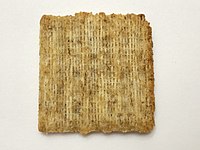 | |
 | |
| Product type | Cracker |
|---|---|
| Owner | Mondelez International |
| Introduced | 1903; 122 years ago (1903) |
| Previous owners |
|
| Website | www |
Triscuit is a brand name of snack crackers which take the form of baked square whole wheat wafers. Invented in 1900, a patent was granted in 1902 and the Shredded Wheat Company began production the next year in Niagara Falls, New York.
History
The Shredded Wheat Company began producing Triscuit in 1903 in Niagara Falls, New York. The name Triscuit may have come from a combination of the words electricity and biscuit or the commonly held belief that "tri" is a reference to the three ingredients used (wheat, oil, and salt), but this is disputed due to conflicting adverts and poor records. At least one early advertisement boasted that Triscuits were "Baked by electricity", claiming they were "the only food on the market prepared by this 1903 process". Each cracker measured 2.25 by 4 inches (5.7 cm × 10.2 cm), and remained that size for nearly 21 years. The ovens were then altered and the cracker size changed to 2-inch (51 mm) squares.
In 1928, the Shredded Wheat Company was purchased by Nabisco.
Beginning in 1935, Triscuits were sprayed with oil and salted. In 1984, additional flavor choices were introduced and the crackers were made crispier.
Overview

| Nutritional value per around 6 crackers | |||||||||||||||||||
|---|---|---|---|---|---|---|---|---|---|---|---|---|---|---|---|---|---|---|---|
| Energy | 502 kJ (120 kcal) | ||||||||||||||||||
| Carbohydrates | 29 g | ||||||||||||||||||
| Sugars | 0 g | ||||||||||||||||||
| Dietary fiber | 3 g | ||||||||||||||||||
| Fat | 3.5 g | ||||||||||||||||||
| Saturated | 0 g | ||||||||||||||||||
| Trans | 0 g | ||||||||||||||||||
| Monounsaturated | 1 g | ||||||||||||||||||
| Polyunsaturated | 2 g | ||||||||||||||||||
| Protein | 3 g | ||||||||||||||||||
| |||||||||||||||||||
| Percentages estimated using US recommendations for adults, except for potassium, which is estimated based on expert recommendation from the National Academies. | |||||||||||||||||||
Triscuits are made from wheat, which is first cooked in water until it reaches about fifty percent moisture content, then tempered to allow the moisture to diffuse evenly in the grain. Slotted rollers form the grain into shredded wheat strands, which are then formed into webs. Several webs are stacked together and the still-moist stack is crimped to produce individual crackers. Oven baking then reduces the moisture content to five percent. The product is currently a 1.75-inch (4.4 cm) square.
References
- Perky, Henry. "Filamentous Cracker - Patent No. 713,795". Retrieved 2018-06-30.
- ^ Hughes, Nancy (18 May 2007). "HowStuffWorks - How Triscuits Work". Retrieved 2008-02-02.
- "It's pretty obvious that the Triscuit name is a play on the word biscuit, but it turns out the 'tri' at the beginning doesn't stand for 'three' – it's short for 'electricity'". Business Insider. 2020-03-26.
- Annelise Schoups (April 12, 2018). "Why is Triscuit Called Triscuit?". Rewind & Capture. Retrieved December 7, 2022.
- "Our Products". Triscuit.com. Retrieved December 7, 2022.
- "Why is it Called a Triscuit?". Under Understood. 8 March 2023. Retrieved 22 March 2023.
- "Triscuit: Baked by Electricity". The Montgomery Advertiser. 27 Sep 1903. Retrieved 2019-07-31.
- Smith, Andrew F. (2013-10-28). Food and Drink in American History: A "Full Course" Encyclopedia [3 Volumes]: A "Full Course" Encyclopedia. ABC-CLIO. ISBN 978-1-61069-233-5.
- United States Food and Drug Administration (2024). "Daily Value on the Nutrition and Supplement Facts Labels". FDA. Archived from the original on 2024-03-27. Retrieved 2024-03-28.
- National Academies of Sciences, Engineering, and Medicine; Health and Medicine Division; Food and Nutrition Board; Committee to Review the Dietary Reference Intakes for Sodium and Potassium (2019). "Chapter 4: Potassium: Dietary Reference Intakes for Adequacy". In Oria, Maria; Harrison, Meghan; Stallings, Virginia A. (eds.). Dietary Reference Intakes for Sodium and Potassium. The National Academies Collection: Reports funded by National Institutes of Health. Washington, DC: National Academies Press (US). pp. 120–121. doi:10.17226/25353. ISBN 978-0-309-48834-1. PMID 30844154. Retrieved 2024-12-05.
External links
| Mondelez International | ||
|---|---|---|
| Brands | ||
| Related | ||
| ||
This brand-name food or drink product–related article is a stub. You can help Misplaced Pages by expanding it. |